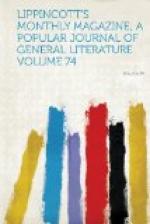L.W.
The Abuse of Adjectives.
It is a great pity that the fairy willow whistle which blew everything into its proper place should have burst with its first note, for there would be such ample opportunity nowadays for the display of its peculiar functions. Why, for instance, should modern novel-writers turn the patient adjective into an overworked little drudge, and compel it to do thrice the labor that it can effectually perform? Fifty years ago it led a life of respected ease, and was only called on when it could be of some real use to the author; now it knows no respite from its ever-increasing tasks, and too often bears upon its weak shoulders the real burden of the book. Formerly we were told that Tilburina had golden hair and blue eyes, or raven hair and black eyes, as the case might be; and, that matter being settled, we heard little more upon the subject. Now the hair and eyes appear anew on every page, and are apparently considered the most important element in the story.
Who has not been struck with the slighting manner in which Sir Walter describes his heroines’ charms? Edith Bellenden, we are asked to believe, was fair without insipidity; Julia Mannering, who is to Waverley what Rosalind is to Shakespeare, is hardly credited with being beautiful at all; while when it comes to his heroes Sir Walter is even more strikingly ineloquent. “A slender young man,” or “a young man of genteel appearance,” is sometimes all that is vouchsafed to us, the rest being happily left to our imagination. Among modern writers, Trollope alone manifests this curious indifference to the hair, eyes, noses, and mouths of his dramatis personae. What was the color of Grace Crawley’s hair, or of Lily Dale’s eyes? What did Archdeacon Grantby look like, or who shall venture to describe the immortal Mrs. Proudie? George Eliot, on the contrary, inclines, especially in her later books, to a lavish use of adjectives; and the aspiring authoress of to-day may cite Gwendolen’s “long brown glance” as being quite as strained as any effort of her own. But then we can no more approach George Eliot by copying a few of her mannerisms than we can become Napoleons by wearing an old coat, or William the Thirds by cultivating an inordinate taste for green peas.
To all, however, who wish to behold this tendency in its fullest and freest development, we would recommend the perusal of a novel by Rhoda Broughton, called “Second Thoughts,”—a bright, vivacious, almost witty little book, marred only by its ineradicable defects of style. The heroine, Gillian Latimer, is described over and over again, with as much emphasis on every feature as if she were one of Madame Tussaud’s pet creations and had nothing but her outward appearance to suggest the real woman she aspires to be. On her eyes alone more adjectives are brought to bear than would have sufficed Scott for all the orbs in Waverley. They are “gray eyes,” “great gray eyes,” “angry




